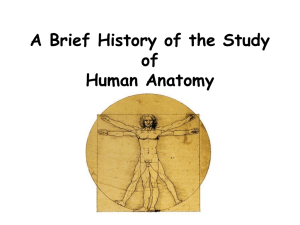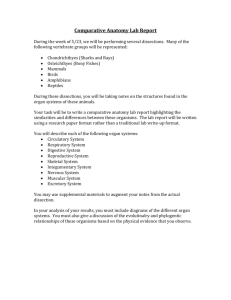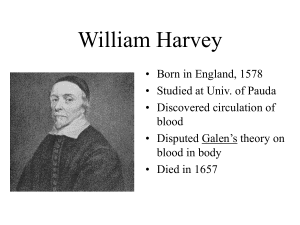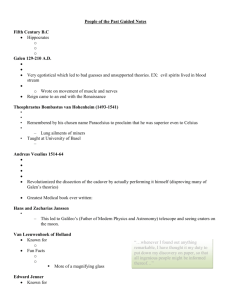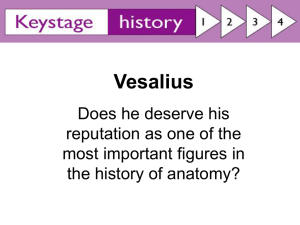History of Anatomy & Physiology Discussion
advertisement
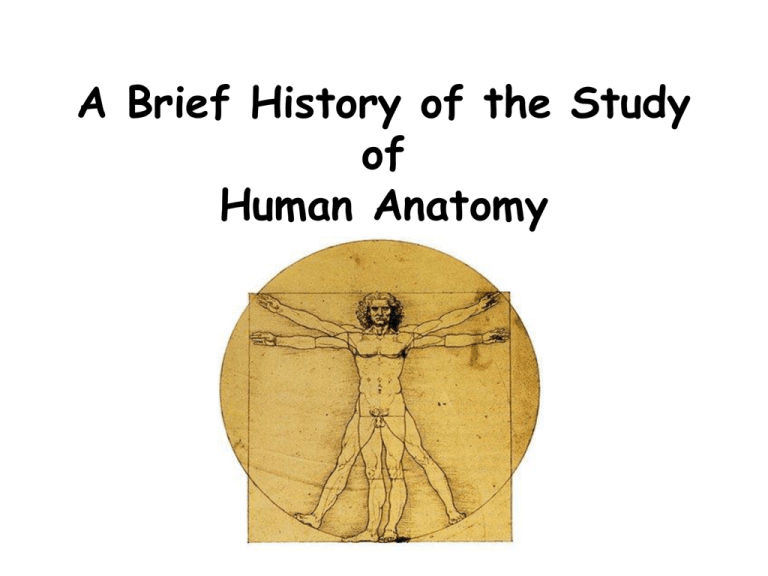
A Brief History of the Study of Human Anatomy Early Egyptians • Perfected the science of mummification. • Major organs were removed and placed in jars. • Body cavity was filled with a “sawdust-like” material. • Body was wrapped in linen cloth shrouds. Alexandria, Egypt • The study of anatomy flourished in Alexandria between 300-150 B.C. • Only criminals were allowed to be dissected because these early cultures were very superstitious and believed that an intact body was necessary for a successful afterlife. Roman Influence • In 30 B.C. Alexandria was conquered by the Roman Empire. • The Romans were interested in power, wealth and military strength, not in anatomical studies. • Romans outlawed anatomical studies and human dissections. Roman Empire Galen of Pergamen • Perhaps one of the brightest spots in the early history of anatomy was the work of a Greek physician named Galen (120-300 A.D.). • Galen had been trained in the Alexandrian tradition and wanted to further the scientific study of the human body. Galen of Pergamen 120-300 A.D. Galen’s Work • Because human dissections were outlawed by the Romans, Galen wrote an anatomy textbook based on his dissections of the Barbary ape, a primate similar to man. • While the text was helpful it had many inaccuracies. The Barbary Ape Title Page of Galen’s Anatomy Text Illustration from Galen’s Text Galen’s Influence • Galen’s anatomy textbook, based on the dissection of the Barbary ape, became the accepted authority on human anatomy for 1300 years! • How could this be? The Dark Ages (400 – 1100 A.D.) • Barbarians from Asia, such as Attila and the Huns, overran and destroyed the Roman Empire. • Many of the scientific writings were destroyed. Dark Ages • Fortunately some of these documents were salvaged by the Moslems and translated into their language, Arabic. Rediscovery • About 1100 A.D., Christian scholars discovered these Arabic translations and began the slow process of translating them into Latin. • This exposed a wealth of lost and forgotten information. • Not until the 16th century were these works finally translated. First Autopsy • In the year 1286 we have reference to a human dissection being performed to determine the cause of death. • Today, this procedure is called an autopsy. Rise of Medical Schools • By the early 1300’s anatomical studies were again becoming fashionable. • In the medical schools in Italy anatomy professors were highly respected figures and so they would sit in large throne-like chairs, wear academic robes, and read from the re-translated text of Galen. Rise of Medical Schools • Barbers actually performed the dissections on human subjects while students stood and observed. • Students were not allowed to participate in the dissections. A Major Contribution • During the early Renaissance years, artists, sculptors and painters strove to make their artwork as human and life-like as possible. • To do this, they had to study human anatomy on a first-hand basis; that is, they had to perform their own human dissections. A Major Contribution • One of the most famous of these Renaissance artists was Leonardo DaVinci. • His anatomically accurate drawings gave to anatomists for the first time illustrations with correct anatomical proportions and great attention to detail. DaVinci’s “Last Supper” Mona Lisa Leonardo’s Anatomy Drawings Leonardo’s Anatomy Drawings Andreas Vesalius • The man who revolutionized the study of anatomy was Andreas Vesalius. • He realized that to learn anatomy students needed to be involved with the dissections. • He also realized that Galen’s textbook was severely flawed and must be replaced. Andreas Vesalius • Vesalius revolutionized the study of anatomy by doing away with the barbers, instead doing human dissections himself and having students assist instead of just observe. • He also published his own anatomy textbook which contained many anatomically accurate drawings based on human dissections. De Humani Corporis Fabrica (1543) De Humani Corporis Fabrica De Humani Corporis Fabrica De Humani Corporis Fabrica Killing Sacred Cows • Vesalius introduced the idea of “killing sacred cows”, that is, challenging accepted authority for the purpose of improving it. • Because of his revolutionary work at the University of Padua, Andreas Vesalius is considered to be the “Father of Modern Anatomy” Fabricius • Vesalius was replaced at the University of Padua by a man named Fabricius. • Fabricius discovered the presence of oneway valves in veins, he called them the “little doors”. “Little Doors” William Harvey • The English physician, William Harvey, a student of Fabricius, became interested in the circulation of the blood. • Harvey was the first person to describe the heart as a pump for blood and he also described arteries and veins as blood vessels that carry blood throughout the body. William Harvey • Harvey showed that “function can be inferred from structure” and thus became known as the “Father of Physiology”. Marcello Malpighi • With the development of the microscope, the Italian anatomist, Marcello Malpighi was able to see the tiny blood vessels that Harvey could not see but had predicted their presence. • These tiny vessels Malpighi named “capillaries”, which means “hair-like” in Latin. The End (Does this look familiar?)
